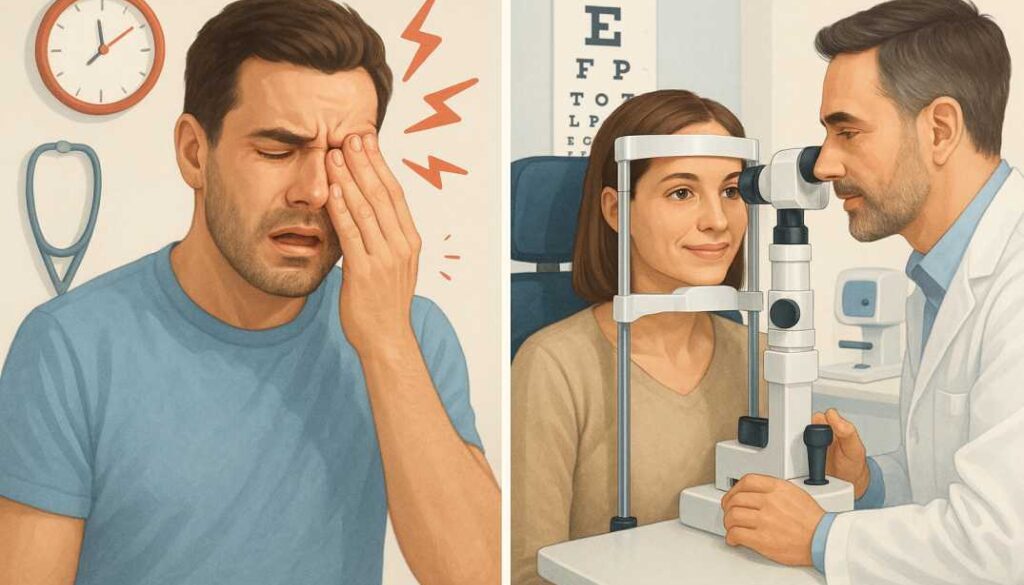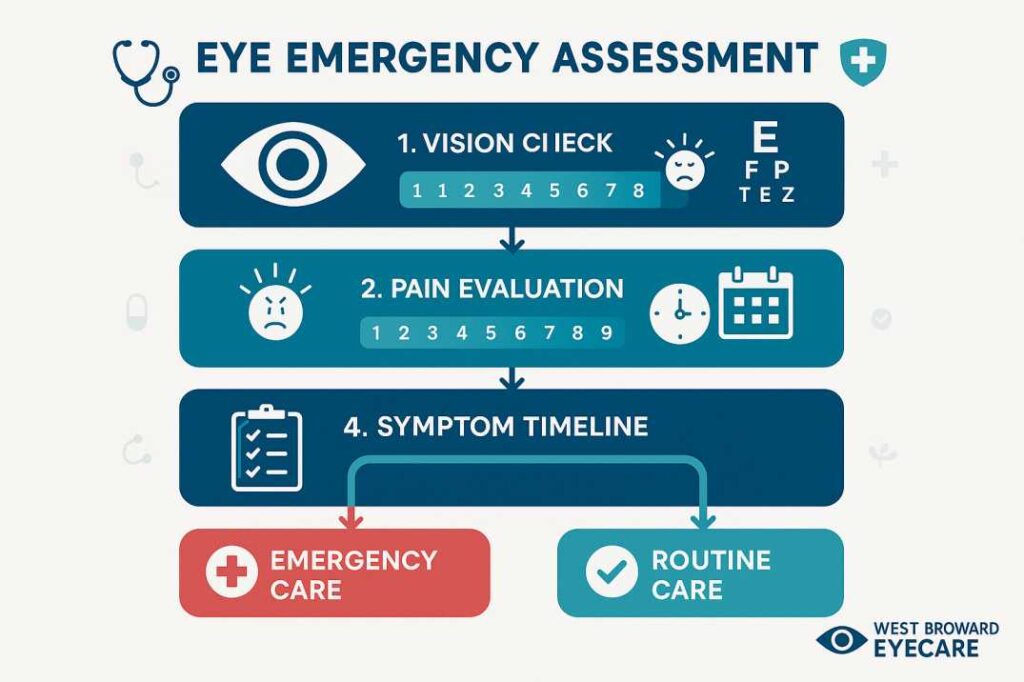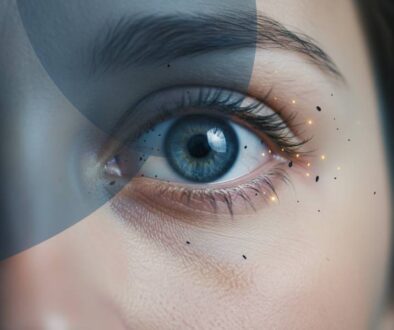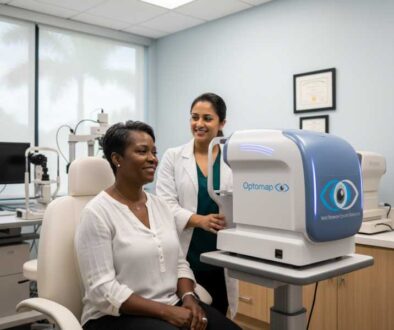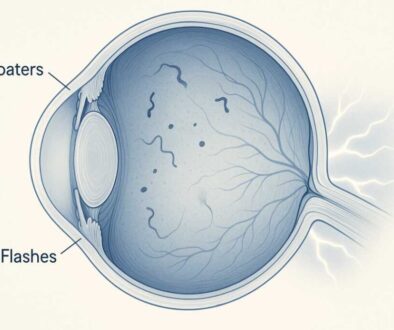Emergency Eye Care Guide: Urgent vs Routine Symptoms
Bottom Line: Early recognition and prompt treatment of eye emergencies can prevent permanent vision loss, while appropriate use of routine care maintains long-term eye health. Understanding this distinction helps you make informed decisions that protect your vision for life.
Understanding Eye Emergencies vs. Routine Care
What Defines an Eye Emergency?
An eye emergency involves any sudden or severe condition that threatens your vision or requires immediate medical intervention to prevent permanent damage. According to recent 2024 research from Turkish emergency departments, only 13% of patients presenting with eye complaints actually had true emergencies, while 60% had relative emergencies and 27% had non-urgent conditions.
True Eye Emergencies demand immediate attention (within minutes to hours):
- Chemical burns or splashes
- Penetrating eye injuries
- Sudden complete vision loss
- Retinal detachment
- Acute angle-closure glaucoma
- Severe eye trauma with visible damage
Relative Eye Emergencies need same-day evaluation but aren’t immediately sight-threatening:
- Corneal foreign bodies
- Corneal abrasions
- Eye infections with pain or discharge
- New onset of flashing lights or floaters
- Sudden onset of double vision
The Critical Time Factor
Time is the most crucial element in eye emergency assessment. Unlike other medical emergencies, where you might have hours or days, some eye conditions can cause irreversible vision loss within 60-90 minutes if left untreated. This is particularly true for:
- Central retinal artery occlusion (eye stroke)
- Chemical burns (especially alkali burns)
- Acute angle-closure glaucoma
- Penetrating trauma with globe rupture
Critical Signs Requiring Immediate Emergency Care
Red Flag Symptoms: Seek Emergency Care Immediately
1. Sudden Vision Loss
When to act: Any rapid decrease in vision, whether partial or complete, in one or both eyes.
Possible causes:
- Retinal detachment
- Central retinal artery or vein occlusion
- Optic nerve damage
- Stroke affecting the visual cortex
What to do: Contact an ophthalmologist immediately or go to the nearest emergency room. Do not wait to see if it improves.
2. Chemical Exposure
When to act: Immediately upon contact with any household cleaners, industrial chemicals, or unknown substances.
Immediate steps:
- Flush eyes with lukewarm water for 15+ minutes
- Remove contact lenses if possible during flushing
- Tilt the head to prevent contamination of the unaffected eye
- Seek immediate emergency care
Why it’s critical: Alkali burns can penetrate through eye tissues in minutes, causing permanent damage. Recent studies show that immediate irrigation before medical care significantly improves outcomes.
3. Penetrating Eye Injury
Recognition signs:
- Visible object protruding from the eye
- Irregularly shaped pupil
- Leaking clear fluid from the eye
- Severe pain with eye movement
Critical actions:
- Never remove any object from the eye
- Cover the eye with a rigid shield (a paper cup works)
- Avoid pressure on the eye
- Seek immediate emergency care
4. Severe Eye Pain with Vision Changes
Concerning combinations:
- Intense eye pain + nausea/vomiting + blurred vision
- Eye pain + seeing halos around lights
- Pain + rapid vision deterioration
Possible condition: Acute angle-closure glaucoma, which can cause permanent vision loss within hours.
New Research on Emergency Recognition
A 2025 systematic review on artificial intelligence in eye emergency triage found that 95% of clinicians reported improved efficiency when using AI-assisted assessment tools. The study identified key predictive factors for true emergencies:
- Age over 65 with sudden vision changes
- History of diabetes with new visual symptoms
- High-impact trauma to the eye area
- Chemical exposure with pH testing showing extremes
When Routine Eye Care is Appropriate
Non-Emergency Conditions
These conditions, while potentially uncomfortable, can typically wait for a scheduled appointment within days to weeks:
Mild to Moderate Symptoms
- Eye redness without pain: Often caused by allergies, dry eyes, or minor irritation
- Itchy, watery eyes: Usually allergic reactions or environmental irritants
- Gradual vision changes: Slow progression over weeks or months
- Dry eye symptoms: Burning, sandy feeling, or mild discomfort
- Stye or chalazion: Small bumps on the eyelid
Routine Preventive Care
- Annual comprehensive eye exams: For vision screening and disease detection
- Contact lens follow-ups: Routine fittings and check-ups
- Prescription updates: When current glasses or contacts become inadequate
- Glaucoma monitoring: Scheduled pressure checks for known patients
- Diabetic eye screenings: Regular retinal examinations for diabetes management
The “48-Hour Rule”
If you’re unsure whether your eye problem constitutes an emergency, apply this guideline: If the condition has been developing gradually over 48 hours or more without sudden deterioration, it’s likely appropriate for routine care scheduling.
However, seek immediate evaluation if:
- Gradual symptoms suddenly worsen
- Vision becomes affected
- Pain increases significantly
- New symptoms develop
Emergency Eye Assessment: Step-by-Step Guide
Self-Assessment Protocol
Before deciding where to seek care, perform this quick assessment:
Step 1: Vision Check
- Cover one eye and test vision with the other
- Can you see clearly enough to read text?
- Is there any vision loss or distortion?
- Test both eyes separately.
Step 2: Pain Evaluation
- Rate pain on a scale of 1-10
- Is the pain getting worse rapidly?
- Does the pain occur with eye movement?
- Are you experiencing nausea with eye pain?
Step 3: Symptom Timeline
- When did symptoms start?
- Did they come on suddenly or gradually?
- What were you doing when symptoms began?
- Have symptoms worsened since the onset?
Step 4: Associated Symptoms
- Headache or nausea?
- Flashing lights or new floaters?
- Double vision?
- Light sensitivity?
Professional Assessment Standards
When you reach a healthcare provider, expect this systematic evaluation:
Visual Acuity Testing
- Distance vision assessment
- Near vision testing
- Comparison between eyes
External Examination
- Eyelid evaluation
- Orbital assessment
- Pupil reaction testing
Advanced Diagnostics
- Intraocular pressure measurement
- Fundoscopic examination
- Slit-lamp examination when indicated
Where to Seek Care: ER vs. Eye Specialist vs. Urgent Care
Emergency Room (ER)
Best for:
- Chemical burns require immediate irrigation
- Penetrating trauma with embedded objects
- Eye injuries associated with head trauma
- When an ophthalmologist is not immediately available
Limitations:
- May lack specialized eye equipment
- General physicians may miss subtle eye conditions
- Longer wait times for non-life-threatening conditions
- Higher costs
Ophthalmologist/Eye Specialist
Best for:
- Any condition affecting vision
- Complex eye problems require specialized diagnosis
- Follow-up care after emergency treatment
- Conditions requiring specialized equipment
Advantages:
- Specialized training and equipment
- Ability to provide definitive treatment
- Comprehensive evaluation capabilities
- Established relationship for ongoing care
Urgent Care Centers
Best for:
- Minor foreign objects in the eye
- Simple conjunctivitis
- Minor scratches or abrasions
- Eye complaints without vision changes
Limitations:
- Cannot handle sight-threatening emergencies
- May lack specialized eye examination equipment
- Usually, staff non-eye specialists
West Broward Eyecare Associates Emergency Protocol
As your local Tamarac eye care providers, we offer:
- Same-day emergency appointments for urgent conditions
- 24/7 emergency consultation line for triage
- Direct communication with the area emergency rooms
- Specialized equipment for comprehensive emergency evaluation
Emergency Contact: (954) 726-0204
Recent Research and Evidence-Based Guidelines
Study 1: Emergency Department Eye Complaint Analysis (2024)
A comprehensive study of 652,224 emergency department patients found that 1.5% presented with eye complaints. Key findings:
- 13% had true emergencies requiring immediate intervention
- 60% had relative emergencies needing same-day care
- 27% had non-emergency conditions
- Common misdiagnoses included mistaking serious conditions for minor irritation
Clinical Implication: Many patients delay care for serious conditions while seeking immediate care for minor issues.
Study 2: Artificial Intelligence in Eye Emergency Triage (2025)
Recent research on AI-assisted eye emergency assessment showed:
- 95% improvement in clinician efficiency
- Reduced triage times through automated initial assessments
- Enhanced accuracy in identifying true emergencies
- Better resource allocation during peak hours
Takeaway: Technology is improving emergency eye care assessment, but human expertise remains essential.
Study 3: Chemical Eye Injury Outcomes (2024)
Analysis of chemical burn treatments revealed:
- Immediate irrigation improved outcomes in 76% of cases
- pH normalization within 30 minutes is crucial for a good prognosis
- Time to treatment directly correlated with final visual acuity
- Grade I-II injuries had a 100% chance of 20/40 or better vision vs. 60% for Grade IV
Key Finding: Every minute counts in chemical eye injuries.
Prevention and Preparedness Strategies
Home Emergency Preparedness
Essential Supplies
- Sterile saline solution for eye irrigation
- Rigid eye shield or clean paper cups
- pH testing strips for chemical exposure assessment
- Emergency contact numbers for local eye care providers
Safety Protocols
- Wear protective eyewear during:
- Sports activities
- Chemical use
- Yard work or construction
- Industrial activities
Workplace Eye Safety
Recent data shows that approximately 40,000 sports-related eye injuries occur annually, with pickleball-related injuries showing a dramatic increase of 405 cases per year from 2021-2024, reaching over 1,200 injuries in 2024 alone.
According to the Bureau of Labor Statistics, 18,510 work-related eye injuries occurred in 2020 (the most recent comprehensive data), with an incidence rate of 1.7 cases per 10,000 full-time workers. Workplace eye injuries account for an estimated $300 million annually in medical bills, compensation, and lost productivity.
Prevention strategies:
- Use appropriate safety glasses that meet ANSI standards
- Follow OSHA eye protection guidelines for specific industries
- Maintain emergency eye wash stations in chemical-exposed areas
- Provide comprehensive employee training in emergency procedures
- Conduct regular workplace hazard assessments
High-Risk Population Awareness
Diabetic Patients
- Schedule annual dilated eye exams
- Monitor for sudden vision changes
- Understand retinopathy warning signs
- Maintain optimal blood sugar control
Senior Adults (65+)
- Increase awareness of glaucoma symptoms
- Regular monitoring for macular degeneration
- Understand the signs of retinal detachment
- Keep current prescription information accessible
West Broward Community-Specific Considerations
Local Tamarac Demographics and Risks
Based on our community analysis:
- 28% of residents are over 65, increasing glaucoma and AMD risk
- High diabetes prevalence requires enhanced retinopathy screening
- Hurricane season considerations for emergency preparedness
- Medicare navigation challenges for emergency care coverage
Tamarac-Specific Emergency Resources
Immediate Care Options
- West Broward Eyecare Associates: (954) 726-0204
- Broward Health Tamarac: Emergency department with ophthalmology consultation
- Urgent care centers: For minor eye complaints
Transportation Considerations
- Proximity advantage for Tamarac residents
- Accessible location on University Drive
- Ample parking for emergency visits
- Public transportation options are available
Insurance and Financial Considerations
Medicare Coverage
- Emergency eye care is typically covered under Medicare Part B when medically necessary
- Part B deductible for 2025: $257 before coverage begins
- Patient responsibility: 20% coinsurance after the deductible is met
- Routine eye exams are NOT covered by Original Medicare
- 99% of Medicare Advantage plans offered vision benefits in 2025
Local Insurance Networks
- Most major insurance plans are accepted
- Medicaid coverage available
- Payment plans for emergency services
- Direct billing to reduce patient burden
Action Steps and Emergency Planning
Create Your Personal Eye Emergency Plan
Information to Keep Accessible
-
Emergency contact numbers:
- West Broward Eyecare Associates: (954) 726-0204
- Local emergency room
- Poison control (for chemical exposure)
-
Medical history:
- Current medications
- Known allergies
- Previous eye surgeries or conditions
- Insurance information
-
Emergency supplies location:
- Sterile saline solution
- Clean cloths or paper cups
- Transportation arrangements
When to Call vs. When to Go
Call First (allows for triage):
- Sudden vision changes without pain
- New floaters or flashing lights
- Gradual onset of symptoms
- Questions about symptom severity
Go Immediately:
- Chemical exposure (after initial irrigation)
- Penetrating injury
- Severe pain with vision loss
- Any trauma with visible eye damage
Resources and Citations
Key Research Studies Referenced
1. Emergency Department Eye Complaint Analysis (2024)
Citation: Yasardag, Y., et al. (2024). “The profile of patients attending the general emergency department with ocular complaints within the last year: is it a true ocular emergency?” BMC Ophthalmology, 24(1), 330.
Link: https://pubmed.ncbi.nlm.nih.gov/39112942/
Key Findings: This comprehensive study of 652,224 emergency department patients found that only 13% of those referred to eye emergency clinics had true emergencies, while 60% had relative emergencies and 27% had non-urgent conditions. The research provides crucial data on emergency vs. routine eye care classification and helps healthcare providers improve triage decisions.
2. Artificial Intelligence in Eye Emergency Triage (2025)
Citation: Nadarajasundaram, R., et al. (2025). “The Role of Artificial Intelligence in Triaging Patients in Eye Casualty Departments: A Systematic Review.” PMC Free Article.
Link: https://pmc.ncbi.nlm.nih.gov/articles/PMC11774558/
Key Findings: This systematic review demonstrated that AI triage systems improved departmental efficiency, with 95% of clinicians reporting reduced time per patient assessment. The study showed AI’s potential to enhance emergency eye care through automated initial assessments and better resource allocation during peak hours.
3. American Academy of Family Physicians – Ocular Emergencies
Citation: American Academy of Family Physicians. (2013, updated 2025). “Common Eye Emergencies.” American Family Physician.
Link: https://www.aafp.org/pubs/afp/issues/2013/1015/p515.html
Key Findings: This authoritative resource provides evidence-based guidelines for recognizing and treating ocular emergencies. It emphasizes that approximately 2 million eye injuries occur annually in the United States, with many leading to vision loss when not promptly treated. The article details critical time factors and treatment protocols for chemical burns, showing that immediate irrigation significantly improves outcomes.
Additional Professional Resources
Medical Organizations and Guidelines
- American Academy of Ophthalmology: Emergency eye care protocols and patient education materials
- American Academy of Family Physicians: Primary care emergency eye assessment guidelines
- Centers for Disease Control and Prevention: Eye injury prevention and statistics
Conclusion
Understanding the difference between eye emergencies and routine eye care can literally save your sight. The key factors in emergency eye assessment are:
- Time sensitivity: True emergencies require action within hours
- Vision impact: Any threat to vision demands immediate evaluation
- Pain severity: Intense eye pain, especially with nausea, suggests serious conditions
- Mechanism of injury: Chemical exposure and penetrating trauma are always emergencies
Remember: When in doubt, seek immediate evaluation. At West Broward Eyecare Associates, we’re committed to being your trusted partner in both emergency and routine eye care. Our expertise in rapid assessment and treatment ensures that you receive the right care at the right time.
As your neighbors in the Tamarac community, we understand the unique needs of our patients and are equipped to handle everything from your child’s first eye exam to complex emergency conditions. Don’t hesitate to contact us for any eye health concerns.
FAQs
-
Seek immediate care for sudden vision loss, severe eye pain, chemical exposure, eye trauma, flashes of light with floaters, or objects stuck in your eye that won’t flush out. These symptoms can indicate serious conditions like retinal detachment or corneal damage.

